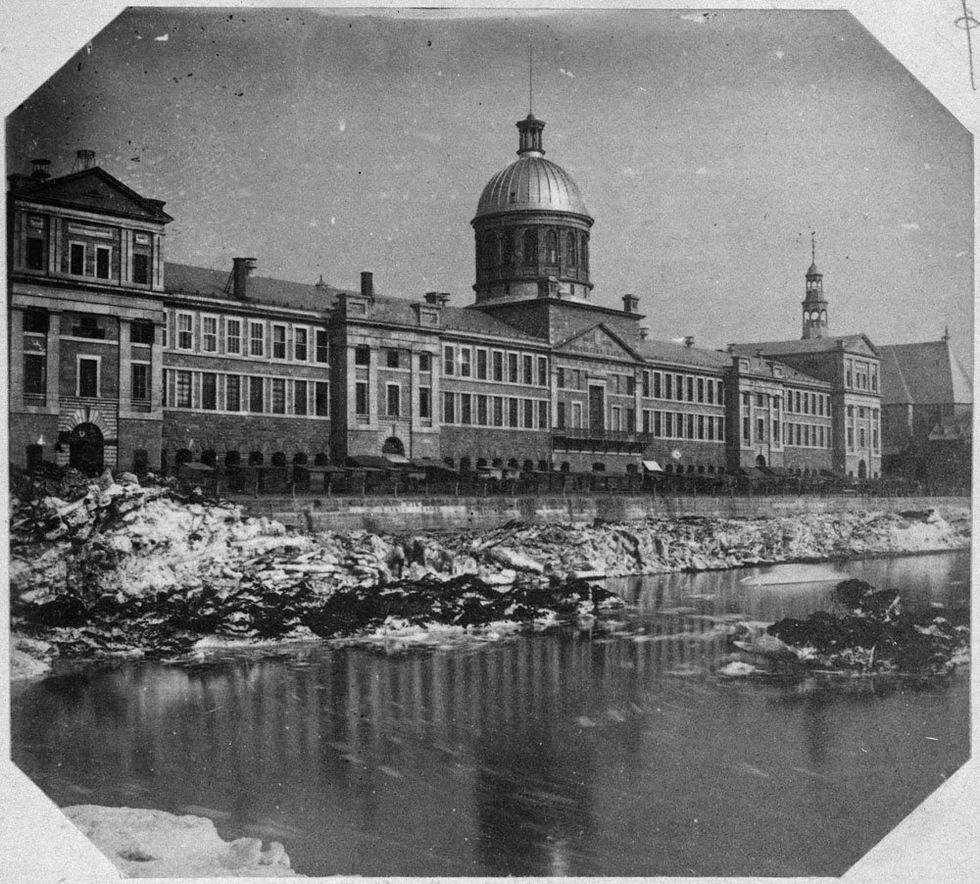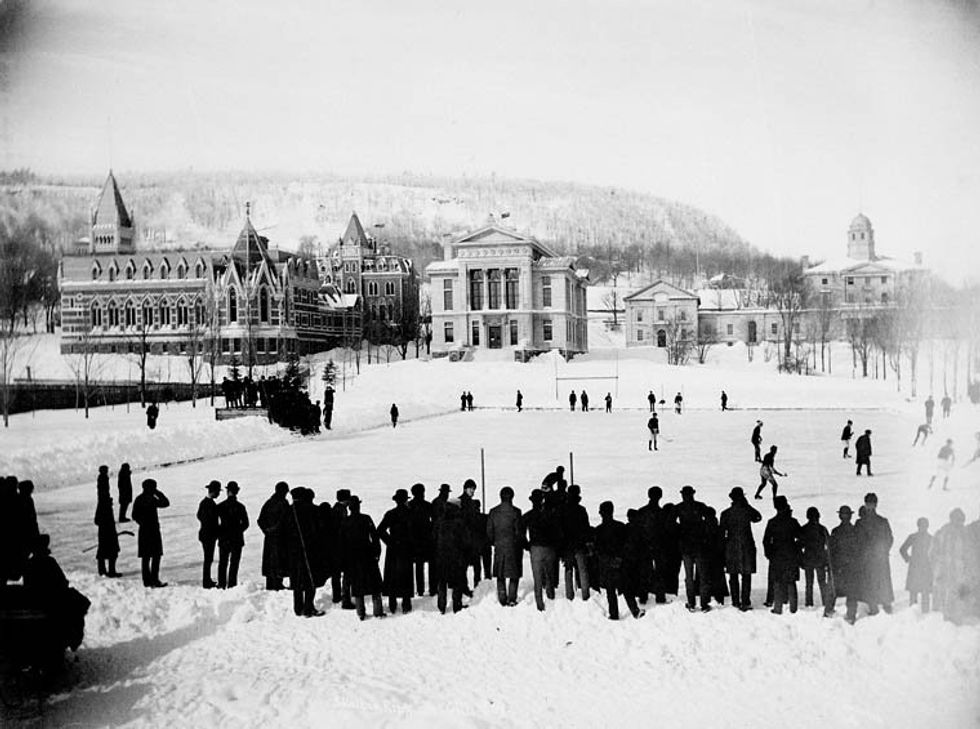Montreal’s history is etched into its architecture, and some of the city’s most iconic structures have remained nearly unchanged for centuries. As new buildings reshape the Montreal skyline, these old landmarks provide a direct link to the city’s past — one built with skills few possess today.
The intricate stonework required for the Notre Dame Basilica’s rebuild is a skill few modern builders have mastered. Just as mind-blowing is imagining these buildings going up without modern technology. One that was a bank now houses a trendy Montreal café, while one that wasn’t a bank held the largest shipment of gold in history in secret.
Here are nine iconic places in Montreal dating back to the city’s early days that you can still visit today:
Victoria Bridge
The newly-constructed Victoria Bridge in 1859.
William England | Wikimedia Commons
The construction of Montreal’s Victoria Bridge was completed in December 1859, seven and a half years before the first Canada Day.
The bridge has stood through both world wars and was the first to carry trains across the St. Lawrence River. It cost $6.6 million to build at the time, including the use of child labor and steamboats. In today’s dollars, that would be roughly $250 million, which was a significant sum — but only an eighth of the $4.2 billion cost of the new Samuel-de-Champlain Bridge.
Sun Life Building
The Sun Life Building opposite the Dominion Square (now Dorchester Square).
Conrad Poirier | Wikimedia Commons
Completed in 1931, the Sun Life Building in Montreal symbolizes the city’s economic might after the Great War. The first phase of construction began in 1913 along Dorchester (now René-Lévesque) to build the first seven storeys. Located at 1155 Metcalfe Street, the neoclassical skyscraper was the largest building in the British Commonwealth at the time of its completion (in terms of square footage).
Designed by the architectural firm of Darling and Pearson, it features impressive stone carvings, grand marble interiors, and a majestic façade.
An intriguing chapter in its history involves a specialized vault in the basement that once held a vast fortune of gold. During World War II, this gold, secretly shipped from Britain, was packed into crates marked “Fish” to avoid detection. The covert operation ensured the safety of British assets from potential enemy forces before being sold on the New York Stock Exchange.
Notre-Dame Basilica
The Notre-Dame Basilica Cathedral, Montreal.
Albertype Company | Library and Archives Canada
The Notre-Dame Basilica, built in 1829, is one of Montreal’s most famous landmarks with its Gothic Revival features. Its intricate wooden interior, designed by Victor Bourgeau, showcases detailed carvings, stained glass windows illustrating biblical scenes, and a majestic pipe organ with 7,000 individual pipes, some over 32 feet long.
The basilica has hosted major historical events, including the funeral of former Canadian Prime Minister Pierre Trudeau in 2000.
Mount Royal Lookout
Mount Royal Lookout in the 1900s.
Albertype Company | Library and Archives Canada
Mount Royal Park, designed by Frederick Law Olmsted and opened in 1876, offers panoramic views of the city. The chalet, built in 1906, was intended to accommodate events and sightseers.
Back then, Montrealers would ascend Mount Royal via a funicular railway that operated on a steep slope between 1884 and 1918. During the dark winter months, it was the starting point for torchlit snowshoe excursions through the mountain’s forest.
Bonsecours Market
Bonsecours Market between 1852 and 1869.
Library and Archives Canada
Bonsecours Market opened its doors in 1847 after five years of construction. The building has long served as a public market, concert hall, and event space. It now houses boutiques, exhibitions, and festivals throughout the year.
The building was closed and even slated for demolition in 1963, but it was repurposed for mixed-use spaces combining business and leisure. Bonsecours Market remains a popular shopping destination in Old Montreal. You can check out La Cave à Manger for a bite to eat or something to drink as you explore the Old Port.
Saint Joseph’s Oratory
Construction of the Saint Joseph’s Oratory dome in 1937.
Conrad Poirier | Wikimedia Commons
Saint Joseph’s Oratory is a stunning example of Renaissance Revival architecture and a well-known Montreal landmark visible from over 100 kilometres away. Founded by Saint Brother André Bessette in 1904, the oratory began as a small chapel and grew into one of the largest churches in the world, completed in 1967.
The oratory features a dome, one of the largest of its kind, standing 97 metres (318 feet) high. The interior houses intricate mosaics, stained glass windows, and an impressive pipe organ. The basilica’s construction cost around $1.5 million at the time, which would be over 20 times that today. An ongoing renovation project will add a visitor-friendly walkway and staircase between the exterior and interior domes.
Royal Bank Tower
Old Montreal in 1937, the Royal Bank Tower stands taller than surrounding buildings at 22 stories.
Library and Archives Canada
Completed in 1928, the Royal Bank Tower at 360 St. Jacques Street is a prime example of neoclassical architecture. The tower features a grand marble entrance and ornate bronze doors, showcasing the elegance and ambition of the era.
Nearly 100 years later, the Royal Bank of Canada has relocated, and Crew Collective & Café has reclaimed the space. It’s now a unique café where people study, work, and sip drinks in the opulent grand hall.
McGill University
The first image of a hockey game in front of McGill in 1884.
Alexander Henderson | Library and Archives Canada
This is likely the first-ever photograph of a hockey match in front of McGill during the 1884 Winter Carnival Hockey Tournament. The Redpath Building (centre) was built in 1882 and would have only been standing for two years when this photo was taken. The Strathcona Medical Building was added in 1907, and many more have been added since.
However, the oldest building on campus is the Arts Building, constructed in 1843, which looks the same almost 200 years later.
Lachine Canal
View of the Old Port entrance to the Lachine Canal in 1889.
Library and Archives Canada
The Lachine Canal, completed in 1825 to bypass the dangerous Lachine Rapids, played a significant role in Montreal’s industrial growth by facilitating the transportation of goods. Stretching 14.5 kilometres from the Old Port of Montreal to Lake Saint-Louis, its construction cost around £90,000, approximately $14 million today. The canal encouraged industrial activity along its banks, establishing Montreal as a major economic centre.
After several expansions and renovations, commercial traffic declined by 1970, leading to its closure as a shipping route. Reopened in 2002 as a recreational area, the canal now features parks, bike paths, and walkways. Popular activities include kayaking, paddle boarding, and visiting the floating spa Bota Bota.
Montreal’s history comes alive through its iconic landmarks, from the historic Lachine Canal to the stunning Saint Joseph’s Oratory and the elegant Royal Bank Tower.
These sites offer a peek into the city’s past, making it a fascinating place to explore for both locals and visitors alike.






















